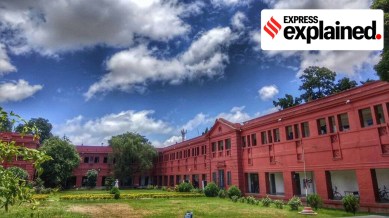Why Union Minister Dharmendra Pradhan wants to change name of historic Ravenshaw College in Cuttack
Several eminent alumni of the state-run Ravenshaw College — which became a university in 2006 and celebrated its sesquicentennial in 2017 — have opposed the renaming one of the oldest and most iconic educational institutions in the country.

Union Education Minister Dharmendra Pradhan has said that he “personally” believes that the name of the prestigious 156-year-old Ravenshaw University in Cuttack should be changed because the British colonial administrator after whom it is named was in charge during the catastrophic famine of 1866 in Orissa (Odisha) in which more than a million people perished.
Several eminent alumni of the state-run Ravenshaw College — which became a university in 2006 and celebrated its sesquicentennial in 2017 — have opposed the renaming one of the oldest and most iconic educational institutions in the country.
Others have pointed out that Thomas Edward Ravenshaw made a significant contribution to Odisha by his promotion of higher education, and by advancing the cause of the Odia language.
Famine and college
The Na Anka Durbhikshya was preceded by a severe drought in eastern India. The famine hit Orissa the hardest, wiping out about a third of the region’s population. In the aftermath of the deaths and devastation, Ravenshaw, who had been appointed commissioner in 1865, submitted a memorandum asking for the establishment of a degree college in Orissa.
Colonial records suggest that Ravenshaw’s proposal was accepted with the condition that the public should contribute Rs 10,000 towards the college. The Maharaja of Mayurbhanj, Krushna Chandra Bhanja Deo, donated Rs 20,000, which contributed significantly to the growth and sustenance of the institution.
The college was founded in 1868 with intermediate level classes at Cuttack Zilla School (now known as Ravenshaw Collegiate School), which was elevated to a degree college in 1876. The college, which was affiliated to Calcutta University and offered courses in English, vernacular composition, Sanskrit, Persian, logic, mathematics, philosophy, physics, chemistry, and botany, was named after Ravenshaw as a tribute to the British officer, who remained in charge of Orissa until 1878.
Ravenshaw College and Ravenshaw Collegiate School were separated in 1904. The present location of the university — the site of a race course, cricket field, and a preferred venue for sports and festivals that was popularly known as Chakra Padia at the time — was chosen in 1913. A M Millwood was the architect who designed the college building.
Orissa’s first university, Utkal University, Bhubaneswar, started functioning in a portion of Ravenshaw College in Cuttack in November 1943.
A glorious history
Over the decades, Ravenshaw College has produced eminent Odia personalities such as Utkal Gourab Madhusudan Das, Acharya Harihara Das, Pandit Gopabandhu Das, and Pandit Nilakantha Das. Great minds such as P K Parija, Kalindi Charan Panigrahi, Annada Shankar Ray, Gopinath Mohanty, and Manoj Das were its alumni.
Former Chief Ministers Harekrushna Mahtab, Biju Patnaik, and Nandini Satpathy, and former Lok Sabha speaker Rabi Ray were students of Ravenshaw College at different times.
Besides being the nerve centre of higher education, Ravenshaw College became a driving force in the civic and political life of Orissa. The literary movement of Sabuja Juga was heralded by the writings of young students of the college such as Annadashankar Roy, Kalindicharan Panigrahi, Baikunthanath Patnaik, Saratchandra Mukherjee, and Harihar Mahapatra. Ravenshaw College faculty often spoke at the Utkal Sahitya Samaj.
When Orissa became a separate province on April 1, 1936, Sir John Austin Hubback was administered the oath of office of Governor at the Ravenshaw College Hall, now called Heritage Hall. The first Provincial Durbar was held at the College Hall on January 9, 1937, and the first Legislative Assembly of Orissa started operating from the Hall on July 28 that year.